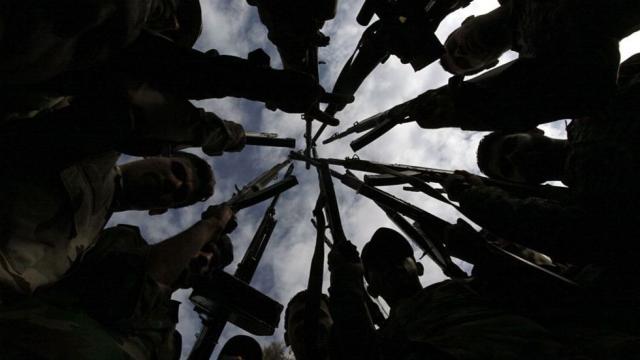http://thehill.com/opinion/national-security/384313-the-myth-of-american-victory-in-syria
U.S. government officials have increasingly argued that the Islamic State has been defeated and the United States should pull out of Syria and shift its focus to state competitors like China and Russia.
The U.S. National Security Strategy noted, “We crushed Islamic State of Iraq and Syria (ISIS) terrorists on the battlefields of Syria and Iraq.” U.S. President Donald Trump similarly remarked that “the United States, under my Administration, has done a great job of ridding the region of ISIS.”
Yet, the Islamic State is far from dead. While the group has lost virtually all the territory it once controlled in Iraq and Syria, between 5,000 and 12,000 Islamic State fighters still remain in Syria as the war enters its seventh year.
More broadly, approximately 40,000 to 60,000 Salafi-jihadist fighters are still in Syria, according to a CSIS database of Salafi jihadists. These numbers indicate that Syria continues to be a major sanctuary for terrorists that could threaten the United States and other Western countries.
Among the most concerning groups today is Hay’at Tahrir al-Sham (or Organization for the Liberation of the Levant). Once a formal affiliate of al Qaeda operating under the name Jabhat al-Nusrah, Hay’at Tahrir al-Sham makes up a significant portion of Syria’s Salafi-jihadist network with between 12,000 and 15,000 fighters.
Established in 2017 and led by a former al Qaeda operative, Muhammad al-Jawlani, Hay’at Tahrir al-Sham is committed to overthrowing the Syrian regime and establishing an extreme version of Islamic law, or sharia, in its place.
The group is predominantly located in Syria’s Idlib province, where it has established a religious police force, banned smoking and covered the heads of mannequins.
Several aspects of Hay’at Tahrir al-Sham should make it worrisome for the United States.
First, the group has deep links into Syria’s jihadist community and could serve as a host for terrorists that are plotting attacks against the United States and other Western countries. One of Hay’at Tahrir al-Sham’s predecessor organizations, Jabhat al-Nusrah, allowed al Qaeda-linked individuals to plan attacks from its sanctuaries in Syria.
U.S. intelligence agencies referred to these plotters as the “Khorasan Group.” In response, the United States targeted Khorasan Group leaders in Syria, like Muhsin al-Fadli and Abdul Mohsen Abdullah Ibrahim al-Sharikh.
Today, several al Qaeda leaders, like Hamza bin Laden, the son of Osama bin Laden, have called for a steady stream of attacks against the United States at home and abroad.
Hay’at Tahrir al-Sham leaders like Muhammad al-Jawlani have already allowed al Qaeda operatives to plot external operations from their territory in the past — making them a serious threat to do so again in the future.
Second, Hay’at Tahrir al-Sham is likely receiving support from the Turkish government, an indication that the group is well-resourced and could secure sanctuary in Turkey if it is pushed out of Idlib by the Assad regime.
The Syrian civil war has been manipulated and perpetuated by numerous outside actors, from Turkey to Saudi Arabia, Qatar, Russia, Iran and even the United States. But Ankara is playing a particularly dangerous game in Syria with its ties to Salafi-jihadist groups.
In the early stages of the war, Turkey’s lax border policy made it the main transit route for foreign fighters into Syria. But Turkey has recently shifted its focus from ousting Assad to expelling Kurdish forces — which have consolidated territory in northern and eastern Syria — from its borders.
Turkish officials are particularly concerned about the Kurdistan Workers’ Party, or PKK, and its local allies, which are engaged in a violent campaign against the Turkish government. Turkey’s willingness to align itself with Salafi-jihadists against the perceived greater evil — the Kurds — will likely increase the ability of jihadists to survive.
The rise of Hay’at Tahrir al-Sham and the persistence of Salafi-jihadist groups highlight the precariousness of Syria. The weakness and illegitimacy of the Syrian government and the substantial number of Salafi-jihadist networks, such as Hay’at Tahrir al-Sham, suggest that Syria will remain a battlefield for the foreseeable future.
Many of the 40,000 to 60,000 Salafi-jihadist fighters in Syria have improved their combat, bomb-making and counterintelligence capabilities and have become dangerous enemies.
It is time for U.S. officials to stop declaring victory against the Islamic State and to stop announcing their intention to leave Syria. Both the Bush and Obama administrations learned the hard way that declaring victory and withdrawing forces too early in a generational struggle against extremists is a fool’s errand.
The rise of Hay’at Tahrir al-Sham in the wake of Islamic State losses indicates that there is a long line of groups ready to fill the vacuum. The United States shouldn’t give them the opportunity.


